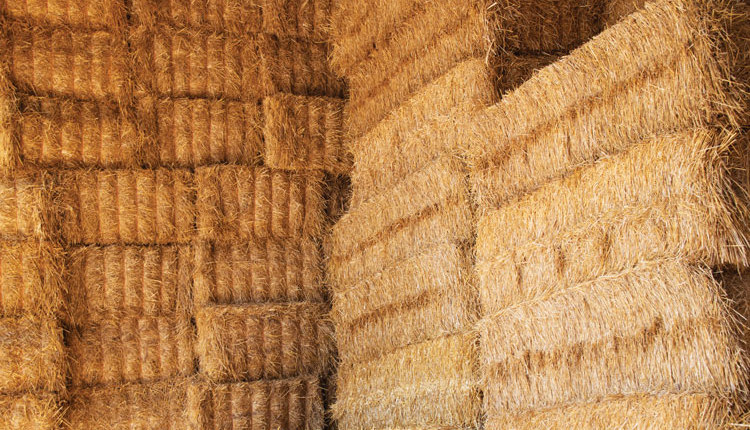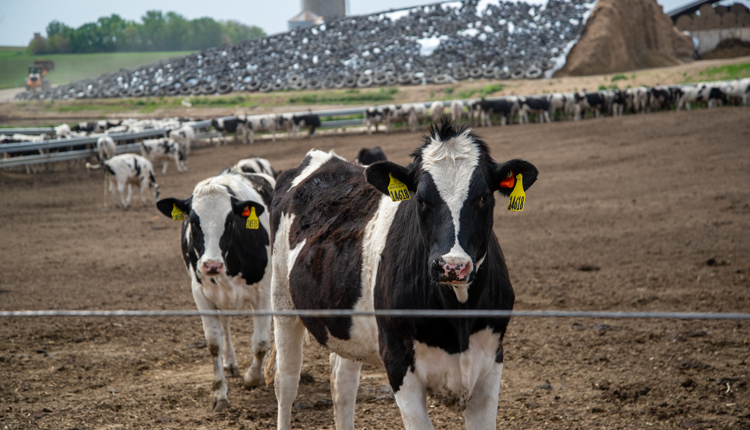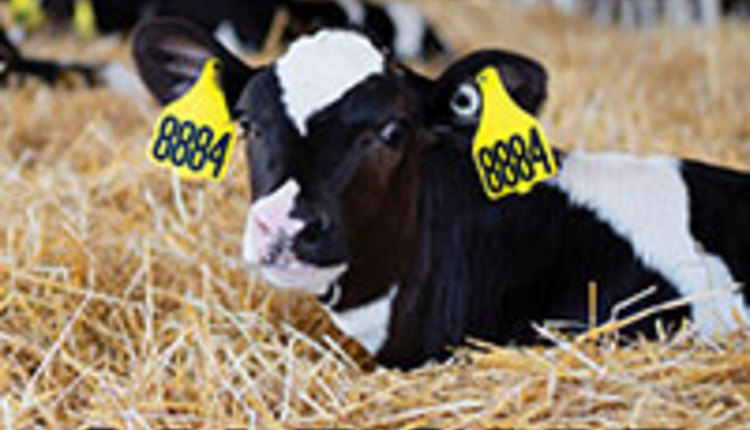The authors are a professor and research associate in the department of dairy and animal science at Penn State and wish to acknowledge the contributions of graduate students Sylvia Kehoe and Meghan Moody in completing the research described here.
Quality hasn't changed much in four decades. However, IgG levels are trending downward while mineral and vitamin levels are higher.
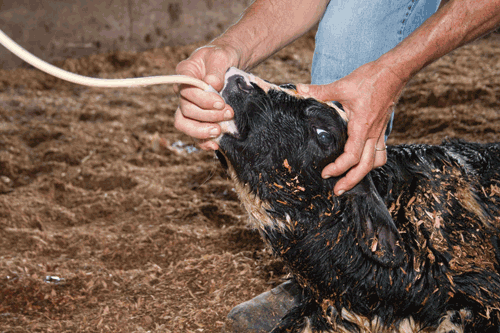
Calf colostrum is the all-important first feed for the calf that allows the calf to be healthy and begin to grow. It provides much needed nutrients and, most importantly, maternal antibodies that protect calves from disease.
Penn State has been conducting a series of studies related to colostrum. Funding for this applied research has been supported by the Animal Health Commission of the Pennsylvania Department of Agriculture. With the exception of immunoglobulin concentrations, it has been many years since colostrum composition has been studied. Over time, changes in genetics, management, and nutrition may have impacted what is currently found in Holstein colostrum, so we set out to see what is in colostrum today.
We visited farms in four major dairy areas in Pennsylvania and collected colostrum samples from Holstein cows. The first components measured were fat, protein, lactose, and total solids. Our analysis showed some relatively standard values, similar to the ones reported 40 years ago (see table below). While the average looked good, the range of samples was very wide.
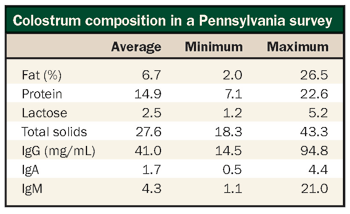
Mineral and some vitamin levels were noticeably higher in these colostrum samples, as compared to studies reported 20 or more years ago, which likely reflects more attention to feeding dry cow minerals now than in years past. Minerals and vitamins fed to dry cows directly impact colostrum, and many of these minerals and vitamins are quite adequate today, making supplemental injections for newborn calves unnecessary in many cases.
Another very important component of colostrum is its immunoglobulin content. This aspect of our samples was more disturbing. Values ranged widely, but the greater concern is that the total immunoglobulin concentration of the samples was 47 mg/mL (to get the total, simply add the amount of IgG, IgA, and IgM). Generally, 50 mg/mL is considered the cutoff point for good versus marginal colostrum. So, on average, our samples showed colostrum immunoglobulin was marginal. While some samples were very high and more than adequate, there were as many that were too low, and some, as noted by the minimum numbers, were extremely low. In fact, these lowest samples could not likely be considered to be true colostrum. Calves fed 4 quarts of this lowest-quality colostrum would not be able to attain adequate immune protection.
Past studies have shown that as first milking colostrum volume goes up, colostrum quality falls on average. A good thumb rule is that if a cow gives more than 15 pounds of first colostrum (provided she is completely milked), there is a good probability that the quality will be marginal or low. Cows with higher genetic potential for milk production secrete more milk and likely increase secretion faster once calving has occurred. Cows that leak substantially or are milked prior to calving have lost much of the value of their true colostrum with this pre-milking or leaking.
In addition, delayed first milking causes lower IgG levels in colostrum. The drop in IgG as time to collecting colostrum increases may be due to re-absorption of immunoglobulins by the cow, dilution of IgG as the amount of milk secreted increases, or a combination of these factors.
Another component of this study was to look at the bacteriological status of the colostrum samples. We found that nearly 30 percent of the samples had standard plate counts greater than those generally considered a standard for quality raw milk (less than or equal to 5,000 cfu/mL). Since we really do not have standards for colostrum, those used for raw milk are suggested as a starting point for comparison.
Our samples tell us that some farms have room for improvement in their collection of colostrum. Whether it means more attention to cleaning the udder and teats prior to milking, regular cleaning and sanitizing of colostrum milkers and collection buckets, or storing colostrum in ways that limit bacterial growth, better colostrum collection practices can help reduce the number of bacteria in colostrum and limit the number of potentially harmful bacteria fed to newborn calves.
In another related study, we wanted to see if the traditional understanding that heifers have poorer colostrum than older cows was still true. For that study, we used four larger farms and analyzed colostrum from every cow that calved during a four-month period. What we found was that, with today's heifer feeding programs, vaccination programs, and management, heifers and older cows have nearly equal colostrum IgG levels. This means there is no need to arbitrarily discard heifer-produced colostrum. Heifer colostrum should be treated like cow colostrum and fed when it meets your criteria which may increase the colostrum supply.
While older cows will often have more diversity of antibodies in their colostrum, many of these older cows produce so much more colostrum that the additional volume dilutes the concentration of immunoglobulins. We found that some heifers actually had higher colostrum immunoglobulin concentrations than older cows.
Many aspects of colostrum management are not new and have not changed drastically; however, we continually see mortality and morbidity rates at the same levels that were found 15 to 20 years ago. One of the definite reasons that we are not seeing these levels go down as we should is colostrum quality and colostrum management practices are not improving as they should. Many of these can be fixed with small changes in management of the newborn and just-fresh cow.
Click here to return to the Calf & Heifer E-Sources
101025_692
Quality hasn't changed much in four decades. However, IgG levels are trending downward while mineral and vitamin levels are higher.

Calf colostrum is the all-important first feed for the calf that allows the calf to be healthy and begin to grow. It provides much needed nutrients and, most importantly, maternal antibodies that protect calves from disease.
Penn State has been conducting a series of studies related to colostrum. Funding for this applied research has been supported by the Animal Health Commission of the Pennsylvania Department of Agriculture. With the exception of immunoglobulin concentrations, it has been many years since colostrum composition has been studied. Over time, changes in genetics, management, and nutrition may have impacted what is currently found in Holstein colostrum, so we set out to see what is in colostrum today.
We visited farms in four major dairy areas in Pennsylvania and collected colostrum samples from Holstein cows. The first components measured were fat, protein, lactose, and total solids. Our analysis showed some relatively standard values, similar to the ones reported 40 years ago (see table below). While the average looked good, the range of samples was very wide.

Mineral and some vitamin levels were noticeably higher in these colostrum samples, as compared to studies reported 20 or more years ago, which likely reflects more attention to feeding dry cow minerals now than in years past. Minerals and vitamins fed to dry cows directly impact colostrum, and many of these minerals and vitamins are quite adequate today, making supplemental injections for newborn calves unnecessary in many cases.
Another very important component of colostrum is its immunoglobulin content. This aspect of our samples was more disturbing. Values ranged widely, but the greater concern is that the total immunoglobulin concentration of the samples was 47 mg/mL (to get the total, simply add the amount of IgG, IgA, and IgM). Generally, 50 mg/mL is considered the cutoff point for good versus marginal colostrum. So, on average, our samples showed colostrum immunoglobulin was marginal. While some samples were very high and more than adequate, there were as many that were too low, and some, as noted by the minimum numbers, were extremely low. In fact, these lowest samples could not likely be considered to be true colostrum. Calves fed 4 quarts of this lowest-quality colostrum would not be able to attain adequate immune protection.
Past studies have shown that as first milking colostrum volume goes up, colostrum quality falls on average. A good thumb rule is that if a cow gives more than 15 pounds of first colostrum (provided she is completely milked), there is a good probability that the quality will be marginal or low. Cows with higher genetic potential for milk production secrete more milk and likely increase secretion faster once calving has occurred. Cows that leak substantially or are milked prior to calving have lost much of the value of their true colostrum with this pre-milking or leaking.
In addition, delayed first milking causes lower IgG levels in colostrum. The drop in IgG as time to collecting colostrum increases may be due to re-absorption of immunoglobulins by the cow, dilution of IgG as the amount of milk secreted increases, or a combination of these factors.
Another component of this study was to look at the bacteriological status of the colostrum samples. We found that nearly 30 percent of the samples had standard plate counts greater than those generally considered a standard for quality raw milk (less than or equal to 5,000 cfu/mL). Since we really do not have standards for colostrum, those used for raw milk are suggested as a starting point for comparison.
Our samples tell us that some farms have room for improvement in their collection of colostrum. Whether it means more attention to cleaning the udder and teats prior to milking, regular cleaning and sanitizing of colostrum milkers and collection buckets, or storing colostrum in ways that limit bacterial growth, better colostrum collection practices can help reduce the number of bacteria in colostrum and limit the number of potentially harmful bacteria fed to newborn calves.
In another related study, we wanted to see if the traditional understanding that heifers have poorer colostrum than older cows was still true. For that study, we used four larger farms and analyzed colostrum from every cow that calved during a four-month period. What we found was that, with today's heifer feeding programs, vaccination programs, and management, heifers and older cows have nearly equal colostrum IgG levels. This means there is no need to arbitrarily discard heifer-produced colostrum. Heifer colostrum should be treated like cow colostrum and fed when it meets your criteria which may increase the colostrum supply.
While older cows will often have more diversity of antibodies in their colostrum, many of these older cows produce so much more colostrum that the additional volume dilutes the concentration of immunoglobulins. We found that some heifers actually had higher colostrum immunoglobulin concentrations than older cows.
Many aspects of colostrum management are not new and have not changed drastically; however, we continually see mortality and morbidity rates at the same levels that were found 15 to 20 years ago. One of the definite reasons that we are not seeing these levels go down as we should is colostrum quality and colostrum management practices are not improving as they should. Many of these can be fixed with small changes in management of the newborn and just-fresh cow.
101025_692









